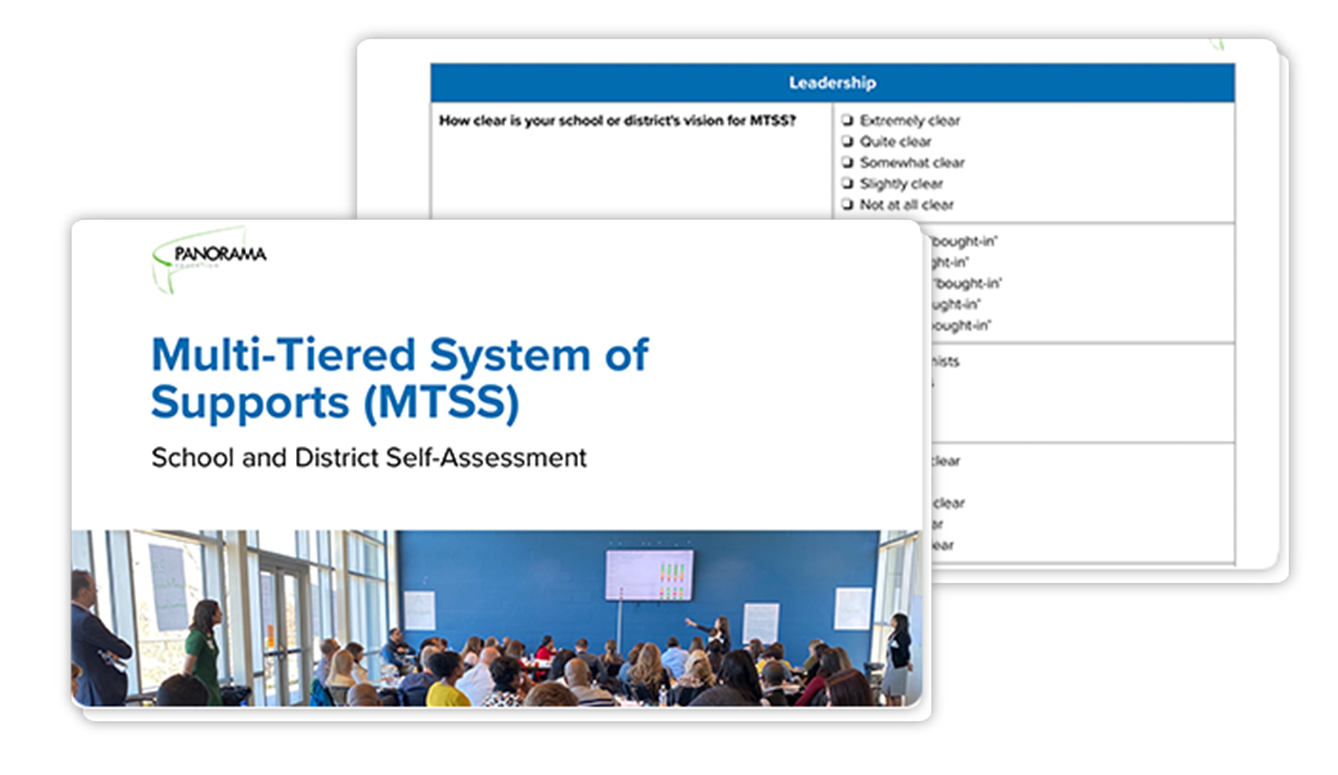If your district has been using a multi-tiered system of supports (MTSS) or Response to Intervention (RTI) framework for supporting students, it may be time to conduct an MTSS self-assessment.
An MTSS self-assessment is a great way to reflect on your MTSS journey so far. What are the strengths in your system? Where are the gaps and opportunities to better support student outcomes?
Implementing and maintaining a strong district-wide MTSS program can be challenging, with a lot of unknowns. By doing a needs assessment, you can make more informed decisions on how to allocate resources at the system level. In addition, school-level MTSS leaders can use the data to identify specific areas for school improvement.
Based on Panorama's work helping school districts build effective MTSS programs, we've identified five key components of MTSS implementation:
- Leadership: How effectively your leadership team articulates a vision for MTSS and guides implementation efforts
- Systems: The alignment and effectiveness of processes for supporting students
- Professional Development: Supporting the training needs of district and school staff
- Tiered Intervention: How effectively your district delivers evidence-based supports to students
- Communication and Collaboration: How effectively your district communicates internally—and with students and families—regarding MTSS
Access our full MTSS Self-Assessment as a PDF or Google Doc to use in your school or district.
Below, we've provided sample questions to ask in each of the five categories. The questions are based on relevant literature, various MTSS implementation rubrics, and pilot runs in school districts.
Feel free to use these questions to create your district's own MTSS self-assessment tool. We hope that they can help spark discussion and action planning among your school and district teams.
MTSS Self-Assessment: Top Questions to Ask
1. Leadership
An effective MTSS starts with a clear vision. Start by assessing the ability of your leadership team to implement MTSS and to mobilize the right people at the district, school, and grade levels.
Key questions to ask:
- How clear is our school or district's vision for MTSS?
- To what extent are staff members "bought-in" to the leadership team’s vision for MTSS implementation?
- Who is primarily responsible for carrying out interventions? (e.g., interventionists, counselors, teachers)
- How clearly are expectations for MTSS implementation documented for staff members?
Explore our pre-written MTSS job descriptions for MTSS Coordinator, MTSS Interventionist, and more!
2. Systems
Next, do a deep dive into the systems and structures in place for MTSS. Your ultimate goal is to achieve system alignment on protocols, meeting structures, and the use of data across teams.
Key questions to ask:
- How clear are decision-making processes or decision rules for assigning students to tiered supports? (e.g., assigning students to Tier 2/Tier 3 supports, progress monitoring)
- How much time do appropriate staff members have to complete the following activities:
- Understand student data
- Disaggregate data to see how different groups of students are doing
- Identify appropriate tiered interventions
- Monitor individual student progress
- Gauge the effectiveness of interventions and implementation fidelity
- Determine next steps for students based on progress monitoring
- Problem solve challenges (e.g., constrained time and resources)
- To what extent are MTSS meetings structured with a clear agenda?
- In student support meetings, how much time do staff members spend reviewing data versus defining interventions for students?
3. Professional Development
As with any district initiative, ongoing professional development is key. Reflect on how well your district has trained educators to understand and apply MTSS best practices with students.
Key questions to ask:
- So far, how effectively have staff been trained on MTSS and why it's important?
- How comfortable do school-level staff feel with the use of data to inform student supports and tiered instruction?
- How much training have staff received on the different types of interventions for every tier?
4. Tiered Intervention
This category covers building an intervention menu, delivering evidence-based supports across multiple domains, and ensuring that your MTSS pyramid is "healthy."
Key questions to ask:
- For which of the following areas does your district currently have established intervention structures and supports? And at which tiers (Tier 1, Tier 2, Tier 3)?
- Academics
- Attendance
- Behavior
- Social-emotional learning
- All of the above
- What percentage of students receive Tier 2 support in your school or district?
- What percentage of students receive Tier 3 support in your school or district?
- How effective is the process to know if an MTSS intervention strategy is successful or needs to change course?
5. Communication and Collaboration
MTSS is a team effort, and requires thoughtful communication practices among teachers, staff, students, and families.
Key questions to ask:
- How equipped are staff in our district to discuss and address the needs of diverse learners (special education students, English Language Learners, students experiencing poverty, and students from marginalized communities)?
- How often does our team use asset-based language when discussing student needs and strengths?
- How often do staff reach out to students and their families to share positive updates?
- How often is staff feedback incorporated to drive continuous improvement of our MTSS process?
How Strong Is Your Multi-Tiered System of Supports?
Panorama's complete MTSS Self-Assessment will help you collect educator perceptions on the state of your MTSS program. Download the self-assessment as a PDF or Google Doc. Then, learn how Panorama's MTSS platform can centralize and strengthen intervention management across your district to improve student outcomes.







